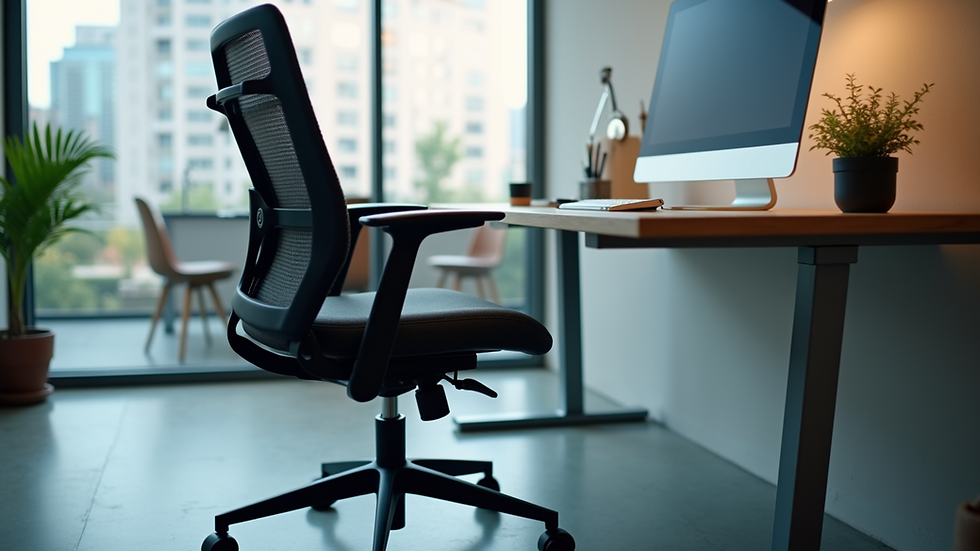How to Choose the Right Chair for Long Work Hours
- MRC Executive Chairs
- May 28
- 4 min read
Choosing the right chair for long work hours is crucial for maintaining both productivity and comfort. With more people working remotely or spending extended hours at desks, the importance of selecting an ergonomic chair cannot be overstated. This blog will guide you through the key factors to consider when choosing the best office chair specifically designed for long hours of use.

Understanding the Importance of an Office Chair
An office chair does more than just provide a seat; it significantly affects your posture, health, and overall work experience. Poor seating can lead to back pain, neck strain, and fatigue, which decreases productivity. In fact, studies suggest that poor ergonomics can cost employers about $300 billion annually in healthcare costs. Therefore, investing in a good chair is not just a matter of comfort, it's also about your well-being and efficiency at work.
Key Features to Look for in an Office Chair
When selecting an office chair for long work hours, look for several key features that enhance comfort and support. Here’s a breakdown:
1. Ergonomic Design
An ergonomic chair is designed to support the natural curve of your spine. Look for a chair with adjustable lumbar support to ease pressure on your lower back. The chair should allow you to sit back while keeping your feet flat on the ground.

2. Material and Cushioning
The material of the chair plays a vital role in your comfort during long hours. Choose a breathable fabric or mesh that promotes airflow and reduces sweating. The cushioning should be firm yet comfortable; too soft, and you risk sinking in, which leads to poor posture.
3. Adjustability
A chair that accommodates various body types is essential. Look for adjustable seat height, armrests, and back angle. Ideally, you should be able to adjust the chair so that your elbows are at a 90-degree angle and your knees are slightly lower than your hips.
4. Wheels and Mobility
If you need to move around your workspace, make sure the chair has smooth, durable wheels. Opt for a five-point star base for stability. This design not only offers more balance but also allows for easier mobility across different surfaces.
5. Cost vs. Quality
While it might be tempting to opt for a cheaper option, investing in a quality chair pays off in the long run. A high-quality chair can last for years and significantly reduce the risk of developing physical problems. Look for chairs that come with a warranty, indicating the manufacturer’s confidence in their product's durability.
Popular Types of Office Chairs
There are several types of chairs available in the market. Here’s a quick overview of a few popular options:
1. Task Chairs
These chairs are generally lightweight and feature adjustable heights. They are suitable for shorter work hours and offer basic ergonomic features.
2. Executive Chairs
If you want something more luxurious, consider an executive chair. These chairs typically provide more padding and a larger build, offering enhanced comfort and support.
3. Mesh Chairs
Mesh chairs are designed with a breathable backing to improve airflow and keep you cool. They often include adjustable lumbar support, making them great for long hours.
4. Kneeling Chairs
These chairs promote a forward-leaning posture that can help reduce back strain. They require some adjustment and may not be suitable for everyone, but they are worth considering if you struggle with back pain.

Tips for Using Your Office Chair Effectively
Once you have chosen the right chair, utilizing it correctly is key to maximizing its benefits. Here are some practical tips:
1. Adjust Your Chair Properly
Take the time to adjust your chair according to your height. Your feet should rest flat on the floor, and your knees should be at a 90-degree angle. Adjust the lumbar support so it fits snugly in your lower back.
2. Practice Good Posture
Even the best chair won’t prevent discomfort if you don’t maintain proper posture. Sit back in your chair, keeping your shoulders relaxed and your elbows close to your body. Invest time in exercises that strengthen your core to support your sitting posture.
3. Take Breaks
No matter how comfortable your chair is, it’s crucial to take regular breaks. Stand, stretch, or walk around every 30 to 60 minutes to re-energize your body. This can help alleviate stiffness and improve circulation.
4. Use Footrests
If your feet can’t reach the floor comfortably, consider using a footrest. This will help maintain proper blood flow and reduce the risk of discomfort.
The Bottom Line on Choosing the Right Chair
Selecting the right chair for long work hours is an investment in your comfort and productivity. Pay attention to features such as adjustability, material, and ergonomic design. Remember that the right chair can make a significant difference in your daily work life.

In the journey to find the perfect office chair, keep these tips and features in mind. Your body will thank you for your careful consideration, and your long hours of work may become more enjoyable and productive as a result.





Comments